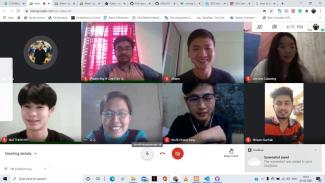
Amid the Covid-19 pandemic, there were periods when schools and institutes of learning needed to move their lessons and examinations online. Students and faculty also had to adjust to this new teaching and learning environment, and work at teaching as effectively in the “virtual” class as they have done in a physical class. Online proctoring also became necessary in order to conduct online exams off-campus.
In online exams without proctoring, there were cases of impersonation and cheating. In these cases, students either asked someone else to take the test on their behalf, or used various methods of cheating, such as by referring to a textbook, using smartphones or other devices to search for answers online or obtain help from a friend.
Overcoming the twin issues of preventing cheating and student authentication was the challenge which Shaun Phua, a third-year student from SMU School of Computing and Information Systems, and his team comprising undergraduates from India and ASEAN took on during the ASEAN-India Hackathon held on 1-4 February 2021. Evaluated on the criteria of Solution appearance, Impact, Technology, Execution, and User Experience, his team took the first runner-up position and walked away with a cash prize of US$1,500.
Working together for the first time, Shaun and his team of five undergraduates from India and across ASEAN developed a solution which utilises the student's smartphone and laptop's camera and microphone for the duration of the exam. AI models were employed during three stages of the exam:
Before the exam, the team’s AI models will perform automatic student face and ID recognition and authentication.
During the exam, continuous voice and video processing is employed to detect signs of cheating (e.g. banned objects such as textbooks, smartphones, other people in the room or voice activity). Appropriate warnings alerts will be handed out to student should the AI model detect suspicious activity.
After the exam, a student's credibility score will be generated based on his/her activity for the duration of the exam.
Explaining the uniqueness of the team’s solution, Shaun said, “Our X-factor was our browser-based AI instead of traditional AI models which require data to be processed by servers on the cloud or more powerful machines. Our lightweight models allow us to run them on smartphones and laptops which lack powerful processing capabilities and may not be connected to high-speed internet. This enables our solution to be highly scalable, cost effective with extremely low latency alerts. We also have a dashboard for the examination administrator to monitor live still captures from the student's smartphone and laptop's camera, as well as each student's credibility score during the exam. The administrator is also able to toggle the intensity or strictness of the AI models and customise the exam questions from the dashboard.”
India’s Union Education Minister Shri Ramesh Pokhriyal and Union Minister of External Affairs Shri Subrahmanyam Jaishankar attended the award ceremony of ASEAN- India Hackathon 2021 on 4 February along with ministers and dignitaries from ASEAN, including Singapore’s Minister for Education Lawrence Wong.
In his speech, Minister Wong noted the mixed-team format of the competition, and said that in these unprecedented times brought about by the Covid-19 pandemic, the need for cross-border innovation and collaboration has never been more crucial. He said,“My hope is that through initiatives such as the ASEAN-India Hackathon, we can continue to inculcate a strong, collaborative, problem-solving mindset amongst our youths, and excite them and inspire them to look into the many other pressing challenges that lie ahead.”
The ASEAN-India Hackathon 2021 was organised by India’s Ministry of Education’s Innovation Cell and the All India Council for Technical Education in collaboration with the Ministry of External Affairs (MEA) and ASEAN countries. It aimed to enhance the cooperation between India and ASEAN countries in science, technology and education.
A total of 330 students and 90 mentors from the 10 ASEAN countries as well as India participated in the Hackathon, which had Blue Economy (i.e. economic activities related to oceans, seas and coasts) and Education as its broad themes. The student teams were divided into 54 cross-country teams, with each team comprising of six students and two mentors. These diverse teams competed on developing the best solution for 11 problem statements provided by various reputed organisations and government bodies. Due to COVID-19 restrictions, the Hackathon was conducted online.
Sharing why he participated in the competition and the experiences gained, Shaun added, “What encouraged me to join the hackathon was the chance to interact with like-minded students from India and ASEAN. Working in a cross-country team is very different to my normal project teams in school. For instance, high-speed internet connectivity might not be a big issue in Singapore due to our advanced fibre network infrastructure; however, this might not be the case in the rural and less-developed areas in India and ASEAN where the students do not have access to high-speed internet at home. The variety of disciplines and different backgrounds in my team enabled us to think more critically and consider the unique socioeconomic factors in different countries when crafting our solutions. This hackathon has taught me how to explore problems from a wider perspective and better empathise with the stakeholders to come up with a holistic solution.”